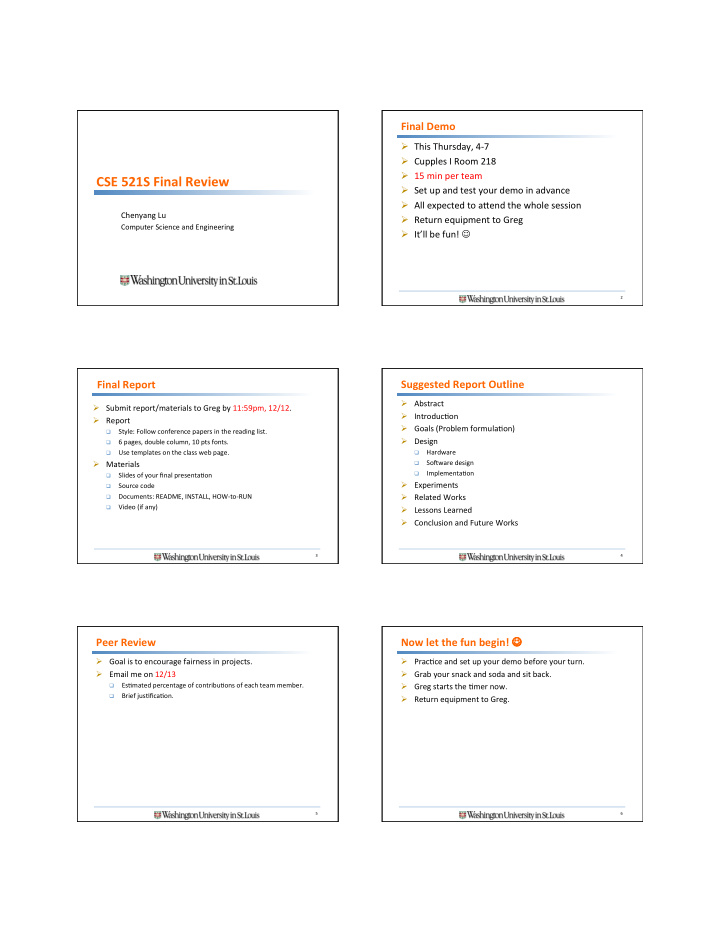



Final ¡Demo ¡ This ¡Thursday, ¡4-‑7 ¡ Cupples ¡I ¡Room ¡218 ¡ 15 ¡min ¡per ¡team ¡ CSE ¡521S ¡Final ¡Review ¡ Set ¡up ¡and ¡test ¡your ¡demo ¡in ¡advance ¡ All ¡expected ¡to ¡aEend ¡the ¡whole ¡session ¡ Chenyang ¡Lu ¡ Return ¡equipment ¡to ¡Greg ¡ Computer ¡Science ¡and ¡Engineering ¡ It’ll ¡be ¡fun! ¡ ¡ 2 ¡ Final ¡Report ¡ Suggested ¡Report ¡Outline ¡ Abstract ¡ Submit ¡report/materials ¡to ¡Greg ¡by ¡11:59pm, ¡12/12. ¡ IntroducWon ¡ Report ¡ Goals ¡(Problem ¡formulaWon) ¡ Style: ¡Follow ¡conference ¡papers ¡in ¡the ¡reading ¡list. ¡ Design ¡ 6 ¡pages, ¡double ¡column, ¡10 ¡pts ¡fonts. ¡ Use ¡templates ¡on ¡the ¡class ¡web ¡page. ¡ Hardware ¡ Materials ¡ Sobware ¡design ¡ ImplementaWon ¡ Slides ¡of ¡your ¡final ¡presentaWon ¡ Experiments ¡ Source ¡code ¡ Documents: ¡README, ¡INSTALL, ¡HOW-‑to-‑RUN ¡ Related ¡Works ¡ Video ¡(if ¡any) ¡ Lessons ¡Learned ¡ Conclusion ¡and ¡Future ¡Works ¡ 3 ¡ 4 ¡ Peer ¡Review ¡ Now ¡let ¡the ¡fun ¡begin! ¡ ¡ Goal ¡is ¡to ¡encourage ¡fairness ¡in ¡projects. ¡ PracWce ¡and ¡set ¡up ¡your ¡demo ¡before ¡your ¡turn. ¡ Email ¡me ¡on ¡12/13 ¡ Grab ¡your ¡snack ¡and ¡soda ¡and ¡sit ¡back. ¡ EsWmated ¡percentage ¡of ¡contribuWons ¡of ¡each ¡team ¡member. ¡ Greg ¡starts ¡the ¡Wmer ¡now. ¡ Brief ¡jusWficaWon. ¡ Return ¡equipment ¡to ¡Greg. ¡ 5 ¡ 6 ¡
Syllabus ¡ Smart ¡Grid ¡ Hardware ¡plaform: ¡Motes ¡ Enables ¡both ¡wired ¡and ¡wireless ¡communicaWon ¡between ¡ Sobware ¡plaform: ¡TinyOS ¡ uWlity ¡companies ¡and ¡household ¡devices ¡ Low-‑power ¡wireless ¡networking ¡ Home ¡Area ¡Network ¡ Link ¡properWes ¡ Power ¡meters, ¡smart ¡thermostats, ¡home ¡appliances. ¡ MAC ¡protocols ¡and ¡architecture: ¡MLA ¡ Topology ¡control: ¡ART ¡ Real-‑Wme ¡scheduling: ¡RTQS ¡ Industrial ¡standard: ¡WirelessHART ¡ Programming ¡models ¡ Mobile ¡agents: ¡Agilla ¡ Service ¡Oriented ¡CompuWng: ¡Servilla ¡ ApplicaWons ¡ Smart ¡energy ¡ Healthcare: ¡Clinical ¡monitoring ¡ Civil ¡infrastructure: ¡Structural ¡health ¡monitoring ¡ 8 ¡ 7 ¡ 8 ¡ Clinical ¡Monitoring ¡ Structural ¡Health ¡Monitoring ¡ First ¡deployment ¡of ¡clinical ¡monitoring ¡ Co-‑design ¡of ¡wireless ¡sensor ¡ system ¡based ¡on ¡wireless ¡sensor ¡ networks ¡and ¡structural ¡engineering ¡ networks. ¡ ¡ algorithms ¡ Wireless ¡pulse ¡oximeter ¡ Successful ¡damage ¡localizaWon ¡on ¡ Low-‑power ¡mesh ¡network ¡ lab ¡structures ¡ Barnes-‑Jewish ¡Hospital ¡Deployment ¡ Advantages ¡over ¡centralized ¡ Orders ¡of ¡magnitude ¡higher ¡frequency ¡ approach ¡ than ¡current ¡pracWce ¡ reduce ¡latency ¡by ¡88% ¡ • 1 ¡reading/min ¡vs. ¡several ¡readings/day. ¡ x3.4 ¡increase ¡in ¡baEery ¡life ¡under ¡ Highly ¡reliable ¡network ¡ an ¡hourly ¡schedule ¡ Developing ¡early ¡detecWon ¡system ¡of ¡ NSF ¡CPS ¡grant ¡(>$1M) ¡ clinical ¡deterioraWon ¡ CollaboraWon ¡with ¡BJH ¡and ¡WUSM. ¡ G. ¡Hackmann, ¡W. ¡Guo, ¡G. ¡Yan, ¡C. ¡Lu, ¡S. ¡Dyke, ¡Cyber-‑Physical ¡Codesign ¡of ¡Distributed ¡ Funded ¡by ¡ICTS ¡(NIH ¡CTSA ¡and ¡BJH) ¡ Structural ¡Health ¡Monitoring ¡with ¡Wireless ¡Sensor ¡Networks, ¡ICCPS'10. ¡ G. ¡Hackmann, ¡F. ¡Sun, ¡N. ¡Castaneda, ¡C. ¡Lu ¡and ¡S. ¡Dyke, ¡A ¡HolisWc ¡Approach ¡to ¡ Decentralized ¡Structural ¡Damage ¡LocalizaWon ¡Using ¡Wireless ¡Sensor ¡Networks, ¡ RTSS’08. ¡ 9 ¡ 10 ¡ Mica2 ¡Mote ¡ Hardware ¡EvoluGon ¡ Processor ¡ Miniature ¡devices ¡manufactured ¡economically ¡ Microcontroller: ¡7.4 ¡MHz, ¡8 ¡bit ¡ Microprocessors ¡ Sensors/actuators ¡ Memory: ¡4KB ¡data, ¡128 ¡KB ¡program ¡ Wireless ¡chips ¡ Radio ¡ Max ¡38.4 ¡Kbps ¡ Sensors ¡ Light, ¡temperature, ¡acceleraWon, ¡acousWc, ¡magneWc… ¡ Power ¡ <1 ¡week ¡on ¡two ¡AA ¡baEeries ¡in ¡acWve ¡mode ¡ >1 ¡year ¡baEery ¡life ¡on ¡sleep ¡modes! ¡ 4.5’’X2.4’’ 1’’X1’’ 1 mm 2 1 nm 2 11 ¡ 12 ¡
Hardware ¡Constraints ¡ SoHware ¡Challenges ¡ Small ¡memory ¡footprint ¡ Severe ¡constraints ¡on ¡power, ¡size, ¡and ¡cost ¡ ¡ Efficiency ¡-‑ ¡power ¡and ¡processing ¡ slow ¡microprocessor ¡ Concurrency-‑intensive ¡operaWons ¡ low-‑bandwidth ¡radio ¡ Diversity ¡in ¡applicaWons ¡& ¡plaform ¡ ¡efficient ¡modularity ¡ Support ¡reconfigurable ¡hardware ¡and ¡sobware ¡ limited ¡memory ¡ limited ¡hardware ¡parallelism ¡ ¡CPU ¡hit ¡by ¡many ¡interrupts! ¡ manage ¡sleep ¡modes ¡in ¡hardware ¡components ¡ 13 ¡ 14 ¡ TinyOS ¡SoluGons ¡ Example: ¡Surge ¡ Efficient ¡modularity ¡ ApplicaWon ¡= ¡scheduler ¡+ ¡graph ¡of ¡components ¡ Compiled ¡into ¡one ¡executable ¡ Only ¡needed ¡components ¡are ¡complied/loaded ¡ ¡ Concurrency: ¡event-‑driven ¡architecture ¡ Main (includes Scheduler) Application (User Components) Actuating Sensing Communication Communication Hardware Abstractions Modified from D. Culler et. Al., TinyOS boot camp presentation, Feb 2001 15 ¡ 16 ¡ Two-‑level ¡Scheduling ¡ Coverage ¡of ¡a ¡Radio ¡in ¡Jolley ¡ Events ¡handle ¡interrupts ¡ Interrupts ¡trigger ¡lowest ¡level ¡events ¡ RSS predictions using wall − class model (Jolley) Coverage using wall − class model (Jolley) − 0 9 Events ¡can ¡signal ¡events, ¡call ¡commands, ¡or ¡post ¡tasks ¡ 0 − 10 − 90 Tasks ¡perform ¡deferred ¡computaWons ¡ 9 0 − 85 8 5 − 20 − − 1 1 0 9 − 9 − 85 − − 30 9 0 0 − 80 − 90 − − Interrupts ¡preempt ¡tasks ¡and ¡interrupts ¡ 8 − 80 1 − 80 1 1 5 0 9 8 − 0 − 85 5 − 40 − 8 5 8 1 − 70 − 1 1 − − 80 − 50 − 1 8 − 80 Preempt Tasks 0 − 85 1 0 9 − 85 − 70 − 60 POST 8 0 1 − − 80 7 0 − 60 FIFO − − 7 0 6 − 0 − 70 − − 70 5 0 events − − 8 − 70 − 80 0 commands − 50 − 90 commands Not ¡ circles! ¡ Interrupts Visible ¡impact ¡of ¡walls ¡on ¡predicted ¡coverage ¡areas ¡ Time Hardware 17 ¡ 18 ¡
Recommend
More recommend